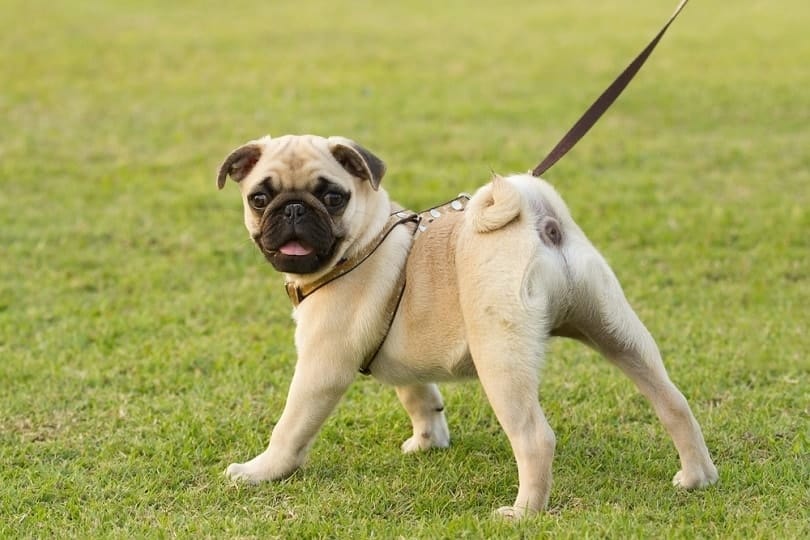If you’re a dog lover and you or one of your family members is allergic to dogs, knowing what dog breeds are hypoallergenic is quite important. If you have your heart set on a Pug or already have one, you might be wondering: Are Pugs hypoallergenic?
Unfortunately, Pugs are definitely not hypoallergenic!
Here, we go over how to make life with a Pug not as unbearable for Pug-loving allergy-sufferers. We also discuss other breeds to avoid, as well as dog breeds that are considered to be hypoallergenic.
Why Are Pugs Bad for Allergy Sufferers?
The main instigators that cause allergies to dogs are:
- Dander: These are the dead skin cells that most mammals with fur have. When dogs shed their fur, dander comes with it and covers many surfaces in the surrounding environment. When dander comes into contact with the nose, eyes, and mouth, this can set off an allergic reaction.
- Saliva: When dogs lick themselves, you, or surfaces in your home, the saliva dries and then can flake off and can become airborne.
- Urine: Urine isn’t always the worst candidate for allergies because dogs typically pee outside, but accidents in the home do happen, which can lead to an allergic reaction.
The problem is that Pugs are known to be copious shedders all year round, so you can expect a large amount of dander. They are prone to sensitive skin, creating even more dry skin and dander.
Pugs also have wrinkled and folded skin, which might lead to skin infections and contribute to more dander. They tend to drool too, which can get caught in the folds around their jowls. All these features lead to one allergy-triggering breed!

Can an Allergy Sufferer Live With a Pug?
If you own a Pug or want to bring one home, there are a few steps that you can take that might help:
- Consider your fabrics:If you have multiple surfaces that attract hair, you might want to look at redecorating. Avoid wools and velvets, and consider leather, denim, satins, and silks. Hair won’t stick as much to these surfaces.
- Vacuum and clean:Frequently cleaning your home will eliminate most of the dander and saliva. You’ll want to invest in a vacuum made for pet hair. Vacuum all surfaces, including stairs, furniture, and curtains. Get into those nooks and crannies. Wash all bedding and clothing in hot water, and consider a HEPA filter for use with an air purifier.
- Don’t let your dog in the bedroom:If you don’t allow your Pug in your bedroom, it will reduce the number of allergens where you sleep.
- Bathe your dog:Bathing your Pug can help reduce their saliva and dander. Only use shampoo for dogs, and don’t bathe your Pug more than once a month, or you risk drying out their skin further. Pay special attention to the skin folds, and try to keep them dry.
- Brush your dog:Use a deshedder or soft-bristled brush, and brush your Pug at least once a week in the winter and summer and several times a week in the spring and fall. Doing this outside would be best.
Dog Breeds That Allergy Sufferers Should Avoid
If a dog sheds and drools excessively, they are not the best choice if you have allergies. These breeds include:
- Basset Hound
- German Shepherd
- Labrador Retriever
- Doberman Pinscher
- Siberian Husky
- Boxer
- Saint Bernard
- Pekingese
- Cocker Spaniel
It doesn’t always matter if the dog is longhaired or shorthaired. It’s all about the slobber and shedding.

Safer Dog Breeds for Allergy Sufferers
These dogs are typically better for allergy sufferers, but there’s no such thing as a completely hypoallergenic breed. Most of these breeds have unique coats (or no coat at all) and don’t drool that much. The Poodle is probably the most well-known, but here are a few others:
- Afghan Hound
- Bichon Frise
- Chinese Crested
- Maltese
- Portuguese Water Dog
- Schnauzer
- Soft Coated Wheaten Terrier
- Yorkshire Terrier
Neither list includes every breed of hypoallergenic and non-hypoallergenic dog. These are just meant to give you an idea of what’s out there.
Final Thoughts
It’s a shame that the adorable Pug isn’t hypoallergenic, but with a little patience and diligence, it is possible to own a Pug even if you are allergic to dogs. Keep up with the cleaning, brushing, and bathing, and invest in an air purifier and a vacuum designed to eradicate pet dander. It’s a great deal of work, but being able to live with your best friend is definitely worth it!
Featured Image Credit: Pixabay














